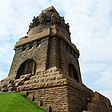ROCHLITZ CASTLE - SAXONY
Elizabeth Von Rochlitz and the Reformation
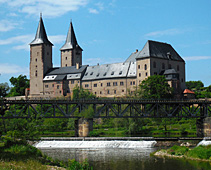 Rochlitz Castle is one of the most important of the medieval castles associated with the Wettin family dynasty which ruled the Saxony regions of Germany and parts of Poland, with branches leading to the Imperial Throne of the Holy Roman German kings and Austrian Empire, and to the English throne of the Windsors through Queen Victoria’s husband Prince Albert of Saxe-Coburg. The castle is most associated with Elisabeth Von Rochlitz, who was the first to introduce Martin Luther’s Reformation in Saxony against the virulent objections of her father-in-law, George “the Bearded” Duke of Saxony. The “of Rochlitz” is more a nickname for her residence at the castle following the death of her husband, as she was more officially Elisabeth Countess of Hesse and Duchess of Saxony. She came from Marburg to marry Prince John of Saxony, but found her relations in Dresden difficult as a convert to Lutheranism. When her husband died in 1537, as a widow she was granted the lands which included Rochlitz and Kriebstein (see Knight's Castle Kriebstein) and declared her holdings to be Protestant. But Elisabeth only lived in Rochlitz Castle for ten years before returning to Hesse in 1547 (see Wilhelmsburg Schmalkaldic League), gaining the lands of Hessian Schmalkalden. It was another Wettin, Frederick III of Saxony who hid Martin Luther at Wartburg Castle following the Edict of Worms, where he began his bible translation (see Martin Luther at Wartburg Castle).
Rochlitz Castle is one of the most important of the medieval castles associated with the Wettin family dynasty which ruled the Saxony regions of Germany and parts of Poland, with branches leading to the Imperial Throne of the Holy Roman German kings and Austrian Empire, and to the English throne of the Windsors through Queen Victoria’s husband Prince Albert of Saxe-Coburg. The castle is most associated with Elisabeth Von Rochlitz, who was the first to introduce Martin Luther’s Reformation in Saxony against the virulent objections of her father-in-law, George “the Bearded” Duke of Saxony. The “of Rochlitz” is more a nickname for her residence at the castle following the death of her husband, as she was more officially Elisabeth Countess of Hesse and Duchess of Saxony. She came from Marburg to marry Prince John of Saxony, but found her relations in Dresden difficult as a convert to Lutheranism. When her husband died in 1537, as a widow she was granted the lands which included Rochlitz and Kriebstein (see Knight's Castle Kriebstein) and declared her holdings to be Protestant. But Elisabeth only lived in Rochlitz Castle for ten years before returning to Hesse in 1547 (see Wilhelmsburg Schmalkaldic League), gaining the lands of Hessian Schmalkalden. It was another Wettin, Frederick III of Saxony who hid Martin Luther at Wartburg Castle following the Edict of Worms, where he began his bible translation (see Martin Luther at Wartburg Castle).
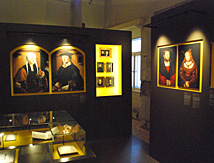 From May to October 2014 a special exhibit to the A Story of Strong Women; 500 Years of the Reformation is being presented at Rochlitz Castle, especially dedicated to Elizabeth of Rochlitz, a strong willed Lutheran convert who introduced the Reformation into the Saxony in 1537, one of the many events leading to the 500 Year Anniversary of the Luther Reformation in 2017. The exhibit offers up a number of artistic interpretations of some of the more forceful females of history represented in Renaissance, including the biblical Judith with the beheaded Assyrian general Holofernes’ head on a platter and Lucretia, who committed suicide after being raped, as well as other figures.
From May to October 2014 a special exhibit to the A Story of Strong Women; 500 Years of the Reformation is being presented at Rochlitz Castle, especially dedicated to Elizabeth of Rochlitz, a strong willed Lutheran convert who introduced the Reformation into the Saxony in 1537, one of the many events leading to the 500 Year Anniversary of the Luther Reformation in 2017. The exhibit offers up a number of artistic interpretations of some of the more forceful females of history represented in Renaissance, including the biblical Judith with the beheaded Assyrian general Holofernes’ head on a platter and Lucretia, who committed suicide after being raped, as well as other figures.
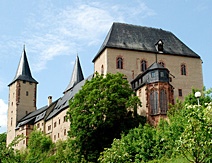 The castle at Rochlitz is one of the oldest in the Sachsen castle land (Schloesserland) at over a thousand years old, built presumably in the 10th Century. The first documented record of the fortress is from 1009, when the Margrave named Gunselin, in an inheritance dispute with his nephews, rather like King Lear, had the castle burned down, rather than divide it. In 1143, the Margrave Konrad I of Wettin acquired the lands and in the following centuries the castle of Rochlitz rose in importance with the power of the Wettins of Saxony. As early at 1156, the castle was joined in a rapid expansion of colonial holdings under Konrad’s fourth son, Dedo.
The castle at Rochlitz is one of the oldest in the Sachsen castle land (Schloesserland) at over a thousand years old, built presumably in the 10th Century. The first documented record of the fortress is from 1009, when the Margrave named Gunselin, in an inheritance dispute with his nephews, rather like King Lear, had the castle burned down, rather than divide it. In 1143, the Margrave Konrad I of Wettin acquired the lands and in the following centuries the castle of Rochlitz rose in importance with the power of the Wettins of Saxony. As early at 1156, the castle was joined in a rapid expansion of colonial holdings under Konrad’s fourth son, Dedo.
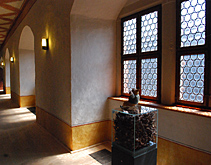 Rochlitz Castle became the permanent residence of Margrave Wilhelm I at the end of the 14th Century who turned the defensive fortress into a residence palace castle, giving it much of its current form, with further refurbishments at the end of the 15th Century under the Wettins who divided the branches of the family, Ernest and Albert, as a widow’s resident seat for their sister Amalia, before the widow’s dower tradition "Wittum" was transferred to the most famous resident Duchess Elisabeth in 1537. Following Elisabeth’s return to Hesse, the castle and lands fell to the Saxony Elector Christian I and his wife Sophie, who had the medieval Rochlitz castle converted to a hunting lodge castle, preferring the newer Baroque palaces of Meissen and Dresden as residences. During the Thirty Years War the castle was besieged a number of times. In the 19th Century it was turned into a court and a jail and at the end of WWII was an allied detention camp for German Wehrmacht officers. During the GDR days the castle was an administrative office. Since April of 2013 the castle’s residential living and state apartments have been opened to visitors.
Rochlitz Castle became the permanent residence of Margrave Wilhelm I at the end of the 14th Century who turned the defensive fortress into a residence palace castle, giving it much of its current form, with further refurbishments at the end of the 15th Century under the Wettins who divided the branches of the family, Ernest and Albert, as a widow’s resident seat for their sister Amalia, before the widow’s dower tradition "Wittum" was transferred to the most famous resident Duchess Elisabeth in 1537. Following Elisabeth’s return to Hesse, the castle and lands fell to the Saxony Elector Christian I and his wife Sophie, who had the medieval Rochlitz castle converted to a hunting lodge castle, preferring the newer Baroque palaces of Meissen and Dresden as residences. During the Thirty Years War the castle was besieged a number of times. In the 19th Century it was turned into a court and a jail and at the end of WWII was an allied detention camp for German Wehrmacht officers. During the GDR days the castle was an administrative office. Since April of 2013 the castle’s residential living and state apartments have been opened to visitors.
Rochlitz Castle Tour
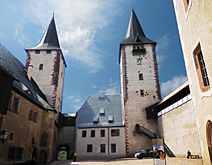 A self-guided tour of the complex leads through almost a labyrinthine connection of halls and stairs around the outer chambers. The most distinctive feature of the castle are the twin towers rising above the banks of the Zwickau Mulde River, which give it more the appearance of a cathedral than a fortress. The towers named “Light Jupe” and “Dark Jupe” but where a church might have a bell the towers housed two dungeons, where in one can a torture chamber can still be found. The towers were originally designed for residence chambers, but were never finished as living quarters. In one tower 142 steps to the top allow panoramic views of the city of Rochlitz and the Mulde Valley. On the way up, the steps pass the jail cells, with one of them a recreated torture chamber. The other tower houses a library not open to the public.
A self-guided tour of the complex leads through almost a labyrinthine connection of halls and stairs around the outer chambers. The most distinctive feature of the castle are the twin towers rising above the banks of the Zwickau Mulde River, which give it more the appearance of a cathedral than a fortress. The towers named “Light Jupe” and “Dark Jupe” but where a church might have a bell the towers housed two dungeons, where in one can a torture chamber can still be found. The towers were originally designed for residence chambers, but were never finished as living quarters. In one tower 142 steps to the top allow panoramic views of the city of Rochlitz and the Mulde Valley. On the way up, the steps pass the jail cells, with one of them a recreated torture chamber. The other tower houses a library not open to the public.
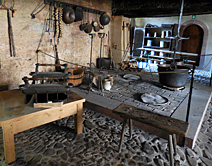 The Prince’s House and Transept offer access to the restored Prince’s Parlor and the Feast Hall. One of the more unique architectural elements is the castle chapel with ribbed vaulted ceiling. The medieval chapel was one of the restorations ordered by the Wettins for their dowager sister Duchess Amalia of Saxony, with the redesign by imperial architect Arnold of Westphalia. Amalia further had the walls painted with fresco, with some of the original fragments of the painting still visible. Referred to as the “Black Kitchen”, the preserved and recreated medieval kitchen of the castle takes up a large dimension on the lower floor, dominated by a broad large fireplace hearth and chimney. Once bustling with activity the aromas from the kitchen would have spread through the whole castle and the name comes from the soot on the walls and ceiling dating from the middle ages. The West Wall Walk leads from one of the towers to the back defensive entrance of the castle and another walk connects with the Princes’s House residential roomsm where you can still see some of the cannon ball damage left from the 30 Years War of Succession, the religion infused contest between Protestant and Catholic rulers of Europe.
The Prince’s House and Transept offer access to the restored Prince’s Parlor and the Feast Hall. One of the more unique architectural elements is the castle chapel with ribbed vaulted ceiling. The medieval chapel was one of the restorations ordered by the Wettins for their dowager sister Duchess Amalia of Saxony, with the redesign by imperial architect Arnold of Westphalia. Amalia further had the walls painted with fresco, with some of the original fragments of the painting still visible. Referred to as the “Black Kitchen”, the preserved and recreated medieval kitchen of the castle takes up a large dimension on the lower floor, dominated by a broad large fireplace hearth and chimney. Once bustling with activity the aromas from the kitchen would have spread through the whole castle and the name comes from the soot on the walls and ceiling dating from the middle ages. The West Wall Walk leads from one of the towers to the back defensive entrance of the castle and another walk connects with the Princes’s House residential roomsm where you can still see some of the cannon ball damage left from the 30 Years War of Succession, the religion infused contest between Protestant and Catholic rulers of Europe.
Visiting Rochlitz Castle
Rochlitz Castle is about 30 minutes from Leipzig and 40 minutes from Dresden. The castle is open Tuesday to Sunday and legal holidays 10 am to 6 pm from March to October, closed November to February. Last Admission is 5 pm. Entrance fee is €8 for adults, €4 reduced for students and seniors, with family tickets available. Rochlitz Caste in included in the Sachsen Schloesserland Pass which is €20 for 10 days, €40 for a full year, with castle free and discounted special exhibits, if you intent to visit some of the many other castles, gardens and palaces of Saxony. © Bargain
Travel Europe
Find best hotel and vacation deals in Leipzig on TripAdvisor
Web
Info
Rochlitz Castle
These articles are copyrighted and the sole property of Bargain Travel Europe and WLPV, LLC. and may not be copied or reprinted without permission. Knights performace photo courtesy Burg Kriebstein.
COLDITZ CASTLE WWII POW ESCAPES
BACH MUSEUM - LEIPZIG
AUERBACHS KELLER - GOETHE INSPIRATION LEIPZIG
MORITZBURG BAROQUE SUMMER PALACE
SAXONY CULTURAL HIGHLIGHTS 2017-2017

